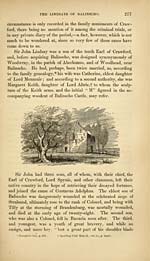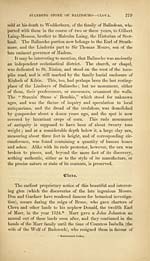Download files
Complete book:
Individual page:
Thumbnail gallery: Grid view | List view

278 LAND OF THE LINDSAYS.
by a cannon bullet," in covering the retreat of Gustavus from
Wolgast in Pomerania, in 1628 — was afterwards Captain in Gus-
tavus's Life Regiment — ultimately rose to the rank of Lieutenant
Colonel — was wounded and left for dead on the field of Liitzen,
in 1632, but recovering, died at Hamburgh seven years after-
wards, leaving his property to his friends and kinsmen, and " a
legacy of four hundred rix-dollars for his funeral."*
Such were the brave brothers of Balinscho. Like the castles
of their more powerful ancestors in other parts of the country,
theirs, too, is a roofless ruin, the part in the sketch being the only
portion now remaining. A circular tower, and other buildings,
stood at the north-east corner down to a late date ; and the
ruins of the more modern house, which was built by Fletcher
(the reputed successor of the Lindsays), stands near by. Many
fine old trees surround the Lindsay castle ; and the orchard,
which occupies an acre and a-half on the south side, is still en-
closed and unploughed, and contains, among many other fruit
trees, one of the largest walnuts that is perhaps to be found in
the kingdom. It is introduced in the prefixed sketch.
Fletcher, who married the youngest daughter of young
Ogilvy of Airlie, who fell at Inverlochy during the civil wars,
was perhaps the first of his name in Balinscho. Though not
of old standing in Scotland, the Fletchers were among the most
ancient and reputable of the English barons, those of Salton
and Inverpeffer (of whom Balinscho was a younger brother) ,f
being direct descendants of Sir Bernard Fletcher of the county
of York, where the family subsisted for many ages. Sir George
Fletcher and his brother James, were proprietors of Bostinofh
about the middle of the seventeenth century, and were patrons of
the church of Forfar, which, together with the teinds, were pur-
chased from them by the magistrates of that burgh about the year
1669 ; \ but whether of the Balinscho family, we are not aware.
It was the penultimate Fletcher of Balinscho, who added the
estate of Lindertis to his original patrimony, and rose to the
rank of Major in the Indian Army. He was succeeded by his
brother, who, in conjunction with the late Lord Panmure, enacted
those youthful vagaries for which he is so well known in the dis-
trict, and remembered as "the daft laird." The estates were
* Lives, vol. ii., pp. 52-56 t Douglas' Baronage, t Old Stat. Acct., vol. vi. p. 513.
by a cannon bullet," in covering the retreat of Gustavus from
Wolgast in Pomerania, in 1628 — was afterwards Captain in Gus-
tavus's Life Regiment — ultimately rose to the rank of Lieutenant
Colonel — was wounded and left for dead on the field of Liitzen,
in 1632, but recovering, died at Hamburgh seven years after-
wards, leaving his property to his friends and kinsmen, and " a
legacy of four hundred rix-dollars for his funeral."*
Such were the brave brothers of Balinscho. Like the castles
of their more powerful ancestors in other parts of the country,
theirs, too, is a roofless ruin, the part in the sketch being the only
portion now remaining. A circular tower, and other buildings,
stood at the north-east corner down to a late date ; and the
ruins of the more modern house, which was built by Fletcher
(the reputed successor of the Lindsays), stands near by. Many
fine old trees surround the Lindsay castle ; and the orchard,
which occupies an acre and a-half on the south side, is still en-
closed and unploughed, and contains, among many other fruit
trees, one of the largest walnuts that is perhaps to be found in
the kingdom. It is introduced in the prefixed sketch.
Fletcher, who married the youngest daughter of young
Ogilvy of Airlie, who fell at Inverlochy during the civil wars,
was perhaps the first of his name in Balinscho. Though not
of old standing in Scotland, the Fletchers were among the most
ancient and reputable of the English barons, those of Salton
and Inverpeffer (of whom Balinscho was a younger brother) ,f
being direct descendants of Sir Bernard Fletcher of the county
of York, where the family subsisted for many ages. Sir George
Fletcher and his brother James, were proprietors of Bostinofh
about the middle of the seventeenth century, and were patrons of
the church of Forfar, which, together with the teinds, were pur-
chased from them by the magistrates of that burgh about the year
1669 ; \ but whether of the Balinscho family, we are not aware.
It was the penultimate Fletcher of Balinscho, who added the
estate of Lindertis to his original patrimony, and rose to the
rank of Major in the Indian Army. He was succeeded by his
brother, who, in conjunction with the late Lord Panmure, enacted
those youthful vagaries for which he is so well known in the dis-
trict, and remembered as "the daft laird." The estates were
* Lives, vol. ii., pp. 52-56 t Douglas' Baronage, t Old Stat. Acct., vol. vi. p. 513.
Set display mode to:
![]() Universal Viewer |
Universal Viewer | ![]() Mirador |
Large image | Transcription
Mirador |
Large image | Transcription
Images and transcriptions on this page, including medium image downloads, may be used under the Creative Commons Attribution 4.0 International Licence unless otherwise stated. ![]()
| Histories of Scottish families > History and traditions of the land of the Lindsays in Angus and Mearns > (296) Page 278 |
|---|
| Permanent URL | https://digital.nls.uk/94872578 |
|---|
| Description | A selection of almost 400 printed items relating to the history of Scottish families, mostly dating from the 19th and early 20th centuries. Includes memoirs, genealogies and clan histories, with a few produced by emigrant families. The earliest family history goes back to AD 916. |
|---|

